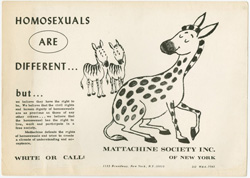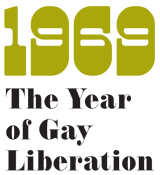1969: The Year of Gay Liberation
 |
The Right to Be
Mattachine Society of New York. "Homosexuals Are Different
. . ." Poster, 1960s.
NYPL, Manuscripts and Archives Division, Mattachine Society
of New York Records.
|
The year 1969 marked a major turning point in the politics of
sexuality in America. Same-sex relationships were discreetly tolerated
in 19th-century America in the form of romantic friendships,
but the 20th century brought increasing legal and medical regulation
of homosexuality, which was considered a dangerous illness.
This
change in attitude was accompanied by pockets of resistance,
spaces that gays and lesbians carved out for their erotic self-expression.
Sometimes these spaces were hidden, like the gay bars in
Greenwich
Village and Harlem that were frequented only by those in
the know. Sometimes they were in plain sight, like the homoerotic
subtexts
and in-jokes of Hollywood movies. The repression of homosexuality
reached its peak in the 1950s with the McCarthy era. During
the paranoia of the Cold War, gays, lesbians, and transgender
people
were seen as a corrupt, lurking menace, easily used as pawns
by communists.
Gays and lesbians began to organize during the 1950s with
the Homophile movement, but were hampered by the lack of a political
language with which to express their experience, as they
were
neither a class nor an ethnicity but, instead, were considered
victims of a moral and medical defect. As gays and lesbians
struggled to organize and represent themselves, the United States
was torn
by a succession of political struggles — the African American
civil rights movement, the women's movement, the protests against
the Vietnam War, and the emergence of the hippie youth subculture — that
transformed the possibilities of political organizing in the United
States. Then, in 1969, the small flames of resistance that activists
around the country had been tending and fanning for decades finally
erupted into a mass political movement sparked by the Stonewall
Riots. Inspired by the tumultuous changes in American culture,
gays and lesbians emerged with a slogan — "Gay Power!"
Clearly understanding that they were making history, these
activists also recognized the need to recover the hidden
history of lesbian, gay, bisexual, and transgender (LGBT) people.
Among
the many activist groups that worked to archive this history
was the International Gay Information Center (IGIC), which grew
out
of the History Committee of the Gay Activists Alliance (GAA).
The IGIC archives operated as a community-based repository
until 1988, when the organization's directors gave the collection
to
The New York Public Library. The IGIC archives, along with
other archives and collections subsequently donated to the Library,
comprehensively document the gay and lesbian civil rights
struggles
in New York since the 1950s and have made NYPL one of the
most important archives of LGBT history in this country. All
the materials
in this exhibition were drawn from these historic collections
in the Library's Manuscripts and Archives Division.
Jason Baumann
Coordinator of Collection Assessment & LGBT Collections
Initial funding for The New York Public Library's LGBT initiative
was provided by Time Warner

Support for The New York Public Library's Exhibitions Program
has been provided by Celeste Bartos, Mahnaz Ispahani and
Adam Bartos, Jonathan Altman, and Sue and Edgar Wachenheim III.

